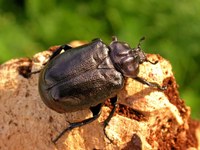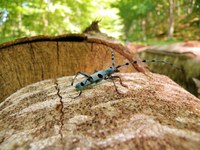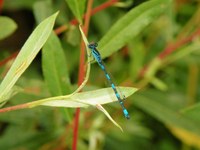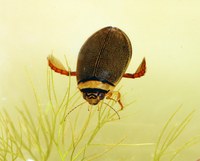The target species
Description
OSMODERMA EREMITA
- Common name: Hermit Beetle

- Description: Saproxylic beetle (feeds on decaying wood) 2.4-3.7 cm long, large glossy black-bronze body; active between June and August.
- Distinguishing marks: the male releases a strong pleasant smell of ripe peaches.
- Habitat: cavities of any species of old broadleaved trees rich in wood mould, in forests, gardens and rows of trees, ranging from the flatlands to the mountains. Larvae feed on dead wood affected by fungal decay.
(Photo of R. Fabbri)
ROSALIA ALPINA
- Common name: Rosalia Longicorn

- Description: Longicorn saproxylic beetle, active between June and August, 1.5-3.8 cm long. Coloration: velvety steely blue-grey with variable black spots.
- Distinguishing marks: elegant colours and distinctive patterns. Both male and female specimen have extremely long antennae with alternating black and blue bands.
- Habitat: mountains, beech forests with decaying trees and in sunlit areas.
(Photo of R. Fabbri)
COENAGRION MERCURIALE CASTELLANII
- Common name: Italian Southern Damselfly

- Description: 2.7-3.1 cm long with a wingspan of 2.5-4.0 cm Thin bright blue body with black markings, flight period April to August.
- Distinguishing marks: a black mark on the second proximal segment of the abdomen similar to the helmet of Mercury, god of the Greek and Roman mythology, hence the name mercuriale.
- Habitats: lower Apennines, small sunlit water streams rich in riparian vegetation, such as seeps and streams with perennial moderate water flow.
(Photo of R. Fabbri)
GRAPHODERUS BILINEATUS
- Common name: Dytiscid Water Beetle

- Description: predator aquatic beetle, active all year round, 1.4-1.6 cm long; broad oval flat body; a broad yellow band between two black bands covers the pronotum, the coloration of elytrae is marbled yellow and black.
- Distinguishing marks: the sides of the elytrae are lined with a band making the insect appear even broader.
- Habitats: the Apennines, generally in large ponds or lakes with clear deep waters, rich in riparian vegetation and bogs.
(Photo of J. Hlasek)
